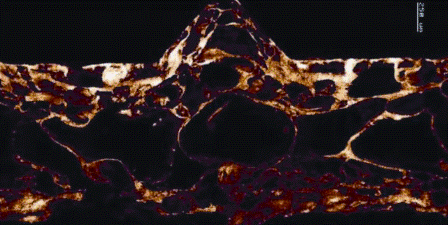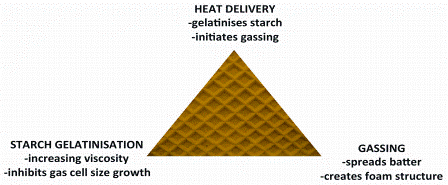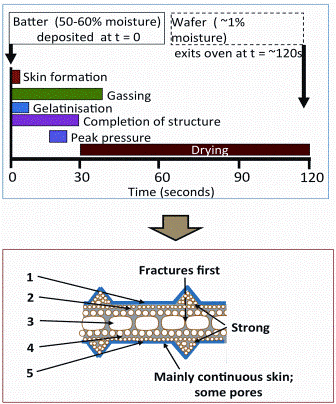The science behind the flat wafer baking process
- Like
- Digg
- Del
- Tumblr
- VKontakte
- Buffer
- Love This
- Odnoklassniki
- Meneame
- Blogger
- Amazon
- Yahoo Mail
- Gmail
- AOL
- Newsvine
- HackerNews
- Evernote
- MySpace
- Mail.ru
- Viadeo
- Line
- Comments
- Yummly
- SMS
- Viber
- Telegram
- Subscribe
- Skype
- Facebook Messenger
- Kakao
- LiveJournal
- Yammer
- Edgar
- Fintel
- Mix
- Instapaper
- Copy Link
Posted: 5 September 2012 | Venkata R. Sundara, Group Leader for Aerated and Filled Confectionery, Nestlé Product Technology Centre | 2 comments
Wafers offer a unique sensorial experience to consumers. Driven by consumer trends towards products which are lighter but still indulgent, the wafer category is expected to grow further. Wafers are seldom eaten alone and are often combined with components with a contrasting texture, such as chocolate or ice cream. Wafers are intermediate components used in the manufacture of several top-selling confectionery products. The crispness and lightness contrasts well with soft cream or chocolate. The level of crispness and its retention over shelf life are critical parameters for the quality of wafer based confectionery products.
Wafers have been manufactured and marketed successfully for decades. During this time, minor additions/modifications have been made to suit local requirements. Much literature relates to bread or biscuit baking which has little relevance to wafer1. The architecture of a flat wafer shows gas bubbles dispersed in a solid phase (Figure 2). The nonhomogeneity of gas cell size, shape and distribution suggests that a wafer can be considered as ‘anisotropic foam’. The arrange – ment of solids and gas cells in solid foam such as a wafer determines its mechanical properties and can therefore influence sensory perception2. In order to vary and control wafer texture, it is important to understand the science behind the structure formation during the baking process.
Wafers offer a unique sensorial experience to consumers. Driven by consumer trends towards products which are lighter but still indulgent, the wafer category is expected to grow further. Wafers are seldom eaten alone and are often combined with components with a contrasting texture, such as chocolate or ice cream. Wafers are intermediate components used in the manufacture of several top-selling confectionery products. The crispness and lightness contrasts well with soft cream or chocolate. The level of crispness and its retention over shelf life are critical parameters for the quality of wafer based confectionery products. Wafers have been manufactured and marketed successfully for decades. During this time, minor additions/modifications have been made to suit local requirements. Much literature relates to bread or biscuit baking which has little relevance to wafer1. The architecture of a flat wafer shows gas bubbles dispersed in a solid phase (Figure 2). The nonhomogeneity of gas cell size, shape and distribution suggests that a wafer can be considered as ‘anisotropic foam’. The arrange - ment of solids and gas cells in solid foam such as a wafer determines its mechanical properties and can therefore influence sensory perception2. In order to vary and control wafer texture, it is important to understand the science behind the structure formation during the baking process.
Wafers offer a unique sensorial experience to consumers. Driven by consumer trends towards products which are lighter but still indulgent, the wafer category is expected to grow further. Wafers are seldom eaten alone and are often combined with components with a contrasting texture, such as chocolate or ice cream. Wafers are intermediate components used in the manufacture of several top-selling confectionery products. The crispness and lightness contrasts well with soft cream or chocolate. The level of crispness and its retention over shelf life are critical parameters for the quality of wafer based confectionery products.
Wafers have been manufactured and marketed successfully for decades. During this time, minor additions/modifications have been made to suit local requirements. Much literature relates to bread or biscuit baking which has little relevance to wafer1. The architecture of a flat wafer shows gas bubbles dispersed in a solid phase (Figure 2). The nonhomogeneity of gas cell size, shape and distribution suggests that a wafer can be considered as ‘anisotropic foam’. The arrange – ment of solids and gas cells in solid foam such as a wafer determines its mechanical properties and can therefore influence sensory perception2. In order to vary and control wafer texture, it is important to understand the science behind the structure formation during the baking process.
Essential factors in wafer structure formation
Wafers are formed from flour and water dispersions (batter) with small amounts of fat, sugar, salt and sodium bicarbonate, which are mixed and then confined in preheated moulds3. Yeast may be used in place or in addition to sodium bicarbonate. Gassing and steam generated during baking are reported to create pressure, and the moisture content of the batter (50-60 per cent) falls to a low level, typically around one per cent towards the end of the baking process. The arrangement of solids and gas cells in wafers during the baking process can be attributed mainly to three factors (Figure 3).
Gassing agents – incorporation of gas phase
As seen from the microstructure, incorporation of a gas phase is an essential feature of wafer baking. It is known that the volume of batter deposited is considerably less compared to the volume between the plates. The gassing process is an integral part of spreading the batter and filling the volume between the baking plates. The onset of gassing occurs during the first few seconds of baking. The generation of carbon dioxide, from reactions taking place within batter mixing, is the major leavening force in wafer baking. The two common methods of generating this gas within batter involve yeast fermentation and chemical leavening systems.
Consolidating the solid phase – starch gelatinisation
Wheat flour consists principally of starch granules (some of these are damaged during milling) and fragments of the protein matrix. Gelatinisation of the starch component occurs within the first few seconds of baking. Gelatinisation is the disruption of the crystalline starch granule, and it occurs when starch is heated in the presence of water around/above 60°C. The granules may swell until the volume is as much as five times the original. As the size of the granule increases, the mixture becomes viscous. The extent of gelatinisation depends on the amount of water present and its availability to the starch granule (Figure 4). If the proportion of starch to water is sufficiently great, the starch molecules form a network with the water enclosed in its sponge-like meshes and a gel is produced6. This is the process of increasing batter viscosity during baking, which controls the development of the gas cells. The protein portion of wheat flour might have considerable influence on the viscosity of batter before baking but little influence during the baking process7.
Heat transfer – structure development and fixation
As described above, wafer baking principally involves the development of a foam structure by gas cell formation (gas phase) and gelatinisation of the starch component (solid phase). Wafer baking ovens have several pairs of plates, continuously circulating on a chain. They can be gas or electrically heated and usually operate at temperatures between 140 and 180°C. When the plate temperature is high, the heat transfer from plates to batter is faster. These changes in heat transfer can influence the rate of starch gelatinisation and eventually the strength of the foam structure in wafer.
The heat transfer in wafer baking ovens might involve conduction, radiation and convection mechanisms to varying degrees. The gap between the pair of heating plates is set according to the body thickness of the product. Variation in plate separation can influence the heat transfer from the hot plates to the centre. The baking plates usually carry precisely machined reedings or other engravings with various pitches and depths. The reeding on wafers is primarily considered to increase the mechanical strength of the wafer sheet for prod – uction handling due to the increased amount of small-cell foam with its increased strength. However, another important aspect of reeding is heat delivery to the batter4.
Dynamics of wafer baking process
It is possible to follow the gradual formation of microstructure in wafers by analysing it at various stages of the baking process. Con – siderable changes seem to happen during the first 30 seconds, when the microstructure develops in a phased manner. Sundara et al hypothesised the flat wafer baking process as the competition between gassing and viscous gelatinised starch within the two heated plates. This seemed to result in the development of five-layers in a phased manner4. When batter is deposited on a hot plate, nucleate boiling occurs at the contact between the hot plate and the batter. As the water for nucleate boiling comes from within the batter, a dry skin will form next to the metal due to water vapour being pushed away. A small quantity of water is being used in this process. The gelatinised starch and trapped gases at this contact point are expected to dry instantaneously due to their proximity to the heat source. This corresponds to layers one and five in Figure 5. The skin layer will act as an insulating layer and delay heat transfer from the hot plates to the centre of the batter.
During the next couple of seconds, a subsurface layer will reach sufficient temperature (≥ 60°C) for starch to start gelatinising. The gelatinised starch can now increase in viscosity and try to restrict the growth of gas bubbles formed from gassing agents. When the top plate closes, a similar process for the formation of a subsurface layer is expected to happen. Due to the insulating effect of the surface and sub-surface layers, heat transfer to the centre of the product is delayed. However, the audible hissing suggests that the gassing agent remains active in spreading the batter to non-deposit areas. The delay in heat transfer slows down the gelatinisation of starch, making it less viscous in the centre, thereby allowing gas bubbles in the centre to grow bigger5.
Earlier researchers reported that the solid to gas ratio (relative density) and gas cell distribution are major factors in determining the texture of cellular solids such as wafers8. The experimental results suggested that the first 30 seconds of baking were the most important phase for the formation of microstructure in flat wafers. At this stage, the solids and voids seem to be in their respective places, however a considerable quantity of moisture is held by the product. Subsequent baking time was responsible for the development of colour and flavour due to Maillard reaction and drying.
Conclusions
Creation and control of wafer texture is critical to enable the development of new products with varied crispness. The architecture of flat wafer shows gas bubbles dispersed in a dried gelatinised starch (solid) phase. The texture of the brittle foam is determined by its structure; the relative amounts of gas to solid phase, bubble size, shape and distribution. The dynamics of the baking process explain the importance of heat transfer, gassing agent and the viscosity of gelatinised starch in wafer structure formation. When viscosity of gelatinising starch dominates, it limits the growth of gas cells, resulting in thicker cell walls and therefore a harder structure. When gassing dominates, it encourages the gas cell growth, thereby resulting in thinner cell walls and a weaker structure. Wafer texture can be influenced by manipulation of heat delivery to the batter and an alternative way of delaying or advancing the gelatinisation of starch is by varying plate distance, plate temperature or surface area.
Acknowledgements
The author would like to thank Richard Crisp and John North, for their valuable collaboration in this area of research. Also, he would like to thank Professor Stefan Palzer and Mark Fowler of Nestlé Product Technology Centre (York) for their encouragement to publish this work.
References
1. Manley, D.J.R. (1983). Technology of biscuits, crackers and cookies, Chichester: Ellis Horwood Publishers, 219-234
2. Livings, S.J. (1 994). Physical properties of starch wafers, PhD thesis, Cambridge University, UK
3. Pitchard, P.E. and Stevens, D.J. (1974). Influence of ingredients on the properties of wafer sheets, Food Trade review, 42(8), 9-15
4. Tiefenbacher, K.F. (1993). Wafers, Encyclopaedia of Food Science, Food Technology and Nutrition, Academic Press, 417-420
5. Sundara, V.R., North, J. and Crisp, R.G.T. Methods to create and control texture in wafer, (unpublished Nestlé Internal Communication, 2002), 5-18
6. Stevens, D.J. (1976). The role of starch in baked goods: Part 1 – The structure of wafer biscuit sheets and its relation to composition, Starch, 28(1), 25-29
7. Oliver, G. and Sahi, S.S. (1995). Wafer batters: A rheological study. J. Sci. Fd. Agric.67(2), 221-227
8. Gibson, L.J. and Ashby, M.F. (1999). Cellular solids: Structure and properties, 2nd edition, Cambridge University Press (UK), 6-8
About the author
Venkata R. Sundara holds a BSc (Agriculture), MSc (Food Technology) and PhD (University of Nottingham) in food science and has been actively involved in food research for 28 years. His early research work at the Defence Food Research Laboratory (India) involved developing quick cooking and survival rations for Armed Forces. He then worked at the Federal Research Centre for Nutrition, Karlsruhe (Germany) as an Alexander von Humboldt Research Fellow, before joining Nestlé Research Centre, Lausanne (Switzerland) in 1995. He has had over 33 scientific papers / abstracts and six patents published, with an emphasis on fruits / vegetables, chocolate and dairy chemistry and processing technology. He is a Fellow and Chartered Scientist of IFST (UK). He is currently Group Leader for Aerated and Filled Confectionery and based at Nestlé Product Technology Centre, York, UK.








Dear Sundara
Thanks alot it was perfect.
We would like to produce wafer but we have a problem: when we cut the wafer bread the top layer separete which parameters we have to care?
Because we use wheat flour with protein amount: 7-10% and gluten:20-27% and ash:0.3-0.5.
We don not know what”s our problem!!
Thanks
First, let me thank the author for this article. My question is probably 6 years (publication was in 2012) late, but I would like to know if bacterial destruction during wafer baking studies have been conducted. If yes, could you please send me the references? Thanks.